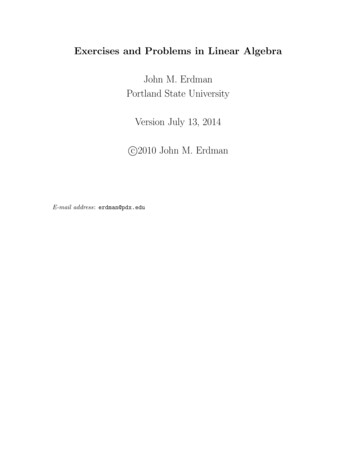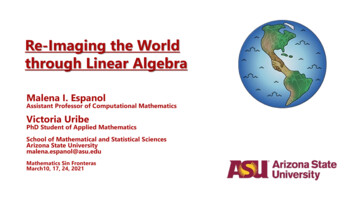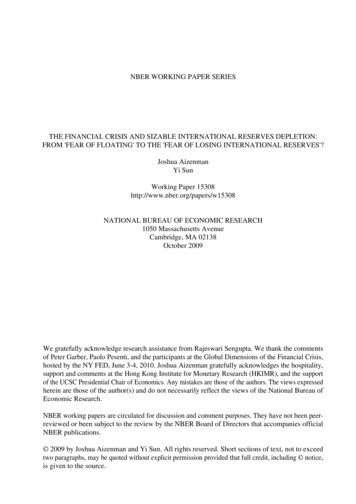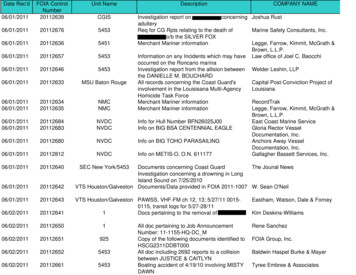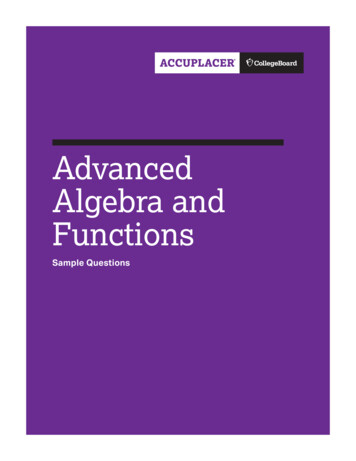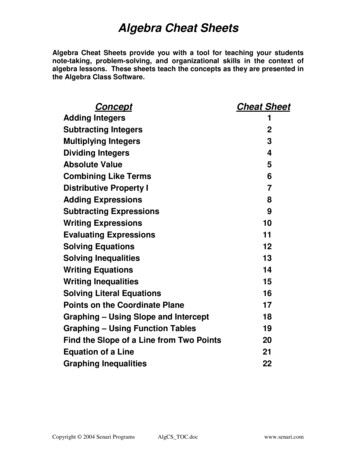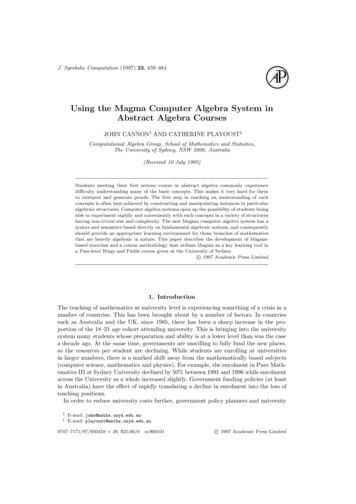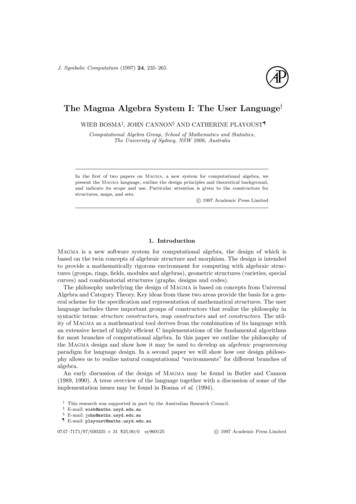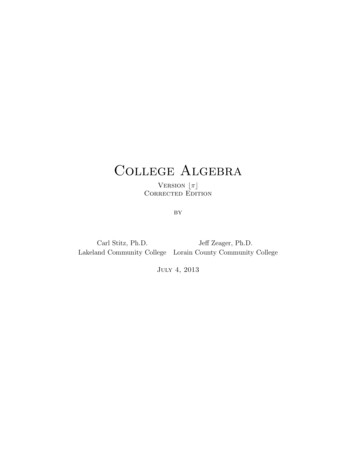
Transcription
LINEAR ALGEBRAJim HefferonFourth editionhttp://joshua.smcvt.edu/linearalgebra
NotationR, R , RnN, C(a . b), [a . b]h. . .ihi,jV, W, U v, 0, 0VPn , Mn m[S] δhB, Di, β,En h e1 , . . . , en i WV M Nh, gt, sRepB ( v), RepB,D (h)Zn m or Z, In n or I T R(h), N (h)R (h), N (h)real numbers, positive reals, n-tuples of realsnatural numbers {0, 1, 2, . . . }, complex numbersopen interval, closed intervalsequence (a list in which order matters)row i and column j entry of matrix Hvector spacesvector, zero vector, zero vector of a space Vspace of degree n polynomials, n m matricesspan of a setbasis, basis vectorsstandard basis for Rnisomorphic spacesdirect sum of subspaceshomomorphisms (linear maps)transformations (linear maps from a space to itself)representation of a vector, a mapzero matrix, identity matrixdeterminant of the matrixrange space, null space of the mapgeneralized range space and null spaceGreek letters with pronounciationcharacterαβγ, Γδ, ζηθ, Θικλ, Λµnamealpha AL-fuhbeta BAY-tuhgamma GAM-muhdelta DEL-tuhepsilon EP-suh-lonzeta ZAY-tuheta AY-tuhtheta THAY-tuhiota eye-OH-tuhkappa KAP-uhlambda LAM-duhmu MEWcharacterνξ, Ξoπ, Πρσ, Στυ, Υφ, Φχψ, Ψω, Ωnamenu NEWxi KSIGHomicron OM-uh-CRONpi PIErho ROWsigma SIG-muhtau TOW (as in cow)upsilon OOP-suh-LONphi FEE, or FI (as in hi)chi KI (as in hi)psi SIGH, or PSIGHomega oh-MAY-guhCapitals shown are the ones that differ from Roman capitals.
PrefaceThis book helps students to master the material of a standard US undergraduatefirst course in Linear Algebra.The material is standard in that the subjects covered are Gaussian reduction,vector spaces, linear maps, determinants, and eigenvalues and eigenvectors.Another standard is the book’s audience: sophomores or juniors, usually witha background of at least one semester of calculus. The help that it gives tostudents comes from taking a developmental approach — this book’s presentationemphasizes motivation and naturalness, using many examples.The developmental approach is what most recommends this book so I willelaborate. Courses at the beginning of a mathematics program focus less ontheory and more on calculating. Later courses ask for mathematical maturity: theability to follow different types of arguments, a familiarity with the themes thatunderlie many mathematical investigations such as elementary set and functionfacts, and a capacity for some independent reading and thinking. Some programshave a separate course devoted to developing maturity but in any case a LinearAlgebra course is an ideal spot to work on this transition. It comes early in aprogram so that progress made here pays off later but it also comes late enoughso that the classroom contains only students who are serious about mathematics.The material is accessible, coherent, and elegant. And, examples are plentiful.Helping readers with their transition requires taking the mathematics seriously. All of the results here are proved. On the other hand, we cannot assumethat students have already arrived and so in contrast with more advancedtexts this book is filled with illustrations of the theory, often quite detailedillustrations.Some texts that assume a not-yet sophisticated reader begin with matrixmultiplication and determinants. Then, when vector spaces and linear mapsfinally appear and definitions and proofs start, the abrupt change brings the
students to an abrupt stop. While this book begins with linear reduction, fromthe start we do more than compute. The first chapter includes proofs, such asthe proof that linear reduction gives a correct and complete solution set. Withthat as motivation the second chapter does vector spaces over the reals. In theschedule below this happens at the start of the third week.A student progresses most in mathematics by doing exercises. The problemsets start with routine checks and range up to reasonably involved proofs. Ihave aimed to typically put two dozen in each set, thereby giving a selection. Inparticular there is a good number of the medium-difficult problems that stretcha learner, but not too far. At the high end, there are a few that are puzzles takenfrom various journals, competitions, or problems collections, which are markedwith a ‘?’ (as part of the fun I have worked to keep the original wording).That is, as with the rest of the book, the exercises are aimed to both buildan ability at, and help students experience the pleasure of, doing mathematics.Students should see how the ideas arise and should be able to picture themselvesdoing the same type of work.Applications. Applications and computing are interesting and vital aspects of thesubject. Consequently, each chapter closes with a selection of topics in thoseareas. These give a reader a taste of the subject, discuss how Linear Algebracomes in, point to some further reading, and give a few exercises. They arebrief enough that an instructor can do one in a day’s class or can assign themas projects for individuals or small groups. Whether they figure formally in acourse or not, they help readers see for themselves that Linear Algebra is a toolthat a professional must have.Availability. This book is Free. See http://joshua.smcvt.edu/linearalgebrafor the license details. That page also has the latest version, exercise answers,beamer slides, lab manual, additional material, and LATEX source. This book isalso available in hard copy from standard publishing sources, for very little cost.See the web page.Acknowledgments. A lesson of software development is that complex projectshave bugs and need a process to fix them. I am grateful for reports from bothinstructors and students. I periodically issue revisions and acknowledge in thebook’s repository all of the reports that I use. My current contact informationis on the web page.I am grateful to Saint Michael’s College for supporting this project over manyyears, even before the idea of open educational resources became familiar.And, I cannot thank my wife Lynne enough for her unflagging encouragement.
Advice. This book’s emphasis on motivation and development, and its availability,make it widely used for self-study. If you are an independent student then goodfor you, I admire your industry. However, you may find some advice useful.While an experienced instructor knows what subjects and pace suit theirclass, this semester’s timetable (graciously shared by G Ashline) may help youplan a sensible rate. It presumes that you have already studied the material ofSection One.II, the elements of ree.III.1Three.IV.2, 3Three.V.1examFive.II.1Five.II.1, 2WednesdayOne.I.1, 2One.III.1Two.I.1, 2Two.III.1Two.III.2, .I.2, II.1Three.II.2Three.IV.1, 2Three.V.1Four.I.1Four.III.1break–Five.II.3As enrichment, you could pick one or two extra things that appeal to you, fromthe lab manual or from the Topics from the end of each chapter. I like the Topicson Voting Paradoxes, Geometry of Linear Maps, and Coupled Oscillators. You’llget more from these if you have access to software for calculations such as Sage,freely available from http://sagemath.org.In the table of contents I have marked a few subsections as optional if someinstructors will pass over them in favor of spending more time elsewhere.Note that in addition to the in-class exams, students in the above course dotake-home problem sets that include proofs, such as a verification that a set is avector space. Computations are important but so are the arguments.My main advice is: do many exercises. I have marked a good sample withX’s in the margin. Do not simply read the answers — you must try the problemsand possibly struggle with them. For all of the exercises, you must justify youranswer either with a computation or with a proof. Be aware that few peoplecan write correct proofs without training; try to find a knowledgeable person towork with you.
Finally, a caution for all students, independent or not: I cannot overemphasizethat the statement, “I understand the material but it is only that I have troublewith the problems” shows a misconception. Being able to do things with theideas is their entire point. The quotes below express this sentiment admirably (Ihave taken the liberty of formatting them as poetry). They capture the essenceof both the beauty and the power of mathematics and science in general, and ofLinear Algebra in particular.I know of no better tacticthan the illustration of exciting principlesby well-chosen particulars.–Stephen Jay GouldIf you really wish to learnyou must mount a machineand become acquainted with its tricksby actual trial.–Wilbur WrightIn the particularis contained the universal.–James JoyceJim HefferonMathematics and Statistics, Saint Michael’s CollegeColchester, Vermont USA -26Author’s Note. Inventing a good exercise, one that enlightens as well as tests,is a creative act, and hard work. The inventor deserves recognition. But textshave traditionally not given attributions for questions. I have changed that herewhere I was sure of the source. I would be glad to hear from anyone who canhelp me to correctly attribute others of the questions.
ContentsChapter One:Linear SystemsI Solving Linear Systems . . . . . . . . . . .I.1 Gauss’s Method . . . . . . . . . . . .I.2 Describing the Solution Set . . . . . .I.3 General Particular Homogeneous .II Linear Geometry . . . . . . . . . . . . . .II.1 Vectors in Space* . . . . . . . . . . .II.2 Length and Angle Measures* . . . . .III Reduced Echelon Form . . . . . . . . . . .III.1 Gauss-Jordan Reduction . . . . . . . .III.2 The Linear Combination Lemma . . .Topic: Computer Algebra Systems . . . . . .Topic: Input-Output Analysis . . . . . . . . .Topic: Accuracy of Computations . . . . . . .Topic: Analyzing Networks . . . . . . . . . . .12132335354250505665677276Chapter Two:Vector SpacesI Definition of Vector Space . . . . . . .I.1 Definition and Examples . . . . .I.2 Subspaces and Spanning Sets . . .II Linear Independence . . . . . . . . . .II.1 Definition and Examples . . . . .III Basis and Dimension . . . . . . . . . .III.1 Basis . . . . . . . . . . . . . . . . .III.2 Dimension . . . . . . . . . . . . .III.3 Vector Spaces and Linear SystemsIII.4 Combining Subspaces* . . . . . . .848496108108121121129136144.
Topic:Topic:Topic:Topic:Fields . . . . . . . . .Crystals . . . . . . .Voting Paradoxes . .Dimensional Analysis.153155159165Chapter Three: Maps Between SpacesI Isomorphisms . . . . . . . . . . . . . . . . . .I.1 Definition and Examples . . . . . . . . .I.2 Dimension Characterizes Isomorphism . .II Homomorphisms . . . . . . . . . . . . . . . .II.1 Definition . . . . . . . . . . . . . . . . . .II.2 Range Space and Null Space . . . . . . .III Computing Linear Maps . . . . . . . . . . . .III.1 Representing Linear Maps with MatricesIII.2 Any Matrix Represents a Linear Map . .IV Matrix Operations . . . . . . . . . . . . . . .IV.1 Sums and Scalar Products . . . . . . . . .IV.2 Matrix Multiplication . . . . . . . . . . .IV.3 Mechanics of Matrix Multiplication . . .IV.4 Inverses . . . . . . . . . . . . . . . . . . .V Change of Basis . . . . . . . . . . . . . . . . .V.1 Changing Representations of Vectors . . .V.2 Changing Map Representations . . . . . .VI Projection . . . . . . . . . . . . . . . . . . . .VI.1 Orthogonal Projection Into a Line* . . .VI.2 Gram-Schmidt Orthogonalization* . . . .VI.3 Projection Into a Subspace* . . . . . . . .Topic: Line of Best Fit . . . . . . . . . . . . . . .Topic: Geometry of Linear Maps . . . . . . . . .Topic: Magic Squares . . . . . . . . . . . . . . . .Topic: Markov Chains . . . . . . . . . . . . . . .Topic: Orthonormal Matrices . . . . . . . . . . 67275275280285295301308313319Chapter Four: DeterminantsI Definition . . . . . . . . . . . . . .I.1 Exploration* . . . . . . . . . .I.2 Properties of Determinants . .I.3 The Permutation Expansion .I.4 Determinants Exist* . . . . . .II Geometry of Determinants . . . . .II.1 Determinants as Size Functions.326326331337346355355.
III Laplace’s Formula . . . . . . . . . . . .III.1 Laplace’s Expansion* . . . . . . .Topic: Cramer’s Rule . . . . . . . . . . . .Topic: Speed of Calculating DeterminantsTopic: Chiò’s Method . . . . . . . . . . . .Topic: Projective Geometry . . . . . . . .Topic: Computer Graphics . . . . . . . . .363363369372376380392Chapter Five:SimilarityI Complex Vector Spaces . . . . . . . . . . . . . . . .I.1 Polynomial Factoring and Complex Numbers*I.2 Complex Representations . . . . . . . . . . . .II Similarity . . . . . . . . . . . . . . . . . . . . . . .II.1 Definition and Examples . . . . . . . . . . . .II.2 Diagonalizability . . . . . . . . . . . . . . . . .II.3 Eigenvalues and Eigenvectors . . . . . . . . . .III Nilpotence . . . . . . . . . . . . . . . . . . . . . . .III.1 Self-Composition*
Advice. itsavailability, makeitwidelyusedforself-study. Ifyouareanindependentstudentthengood

